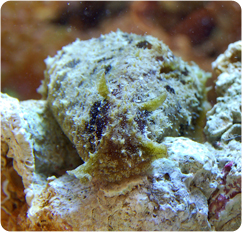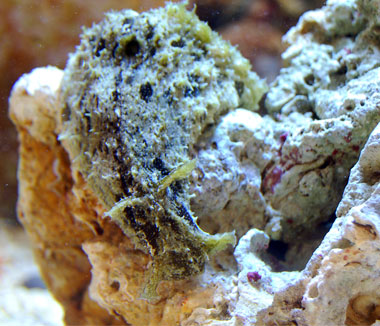|
Family Aplysiidae - Sea Hares
This Oft-Maligned Animal Actually Makes a Great Aquarium Specimen 
The Sea Hare is an herbivorous sea slug that, according to the Ancient Greeks, looks something like a rabbit (more on that in a bit). Sea Hares hail from the Order Anaspidea and the Family Aplysiidae. There are nine genera including the genus Aplysia, which contains the Sea Hares most commonly seen in the hobby. While many aquarists have heard horror stories about Sea Hares "inking," these animals actually make great aquarium specimens if you provide them with the appropriate habitat and meet their dietary needs.
Pound for Pound the Best at Algae Control
All Sea Hares are herbivores, unlike other carnivorous sea slugs (like Chelidonura varians, otherwise known as the Blue Velvet Sea Slug). Sea Hares feed on specific algae or cyanobacteria, and Aplysia species are particularly well-known for their algae-consuming prowess (especially hair algae). The sea hare is very popular and is pound for pound the best at algae control, says Mark Martin, the Director of Marine Ornamental Research at Blue Zoo Aquatics. Sea Hares can be found in all oceans in both temperate and tropical waters. While most are quite small (some are less than an inch), they can grow up to almost 30 inches in length. The Aplysia species offered in the aquarium trade generally grow no longer than one foot.
Its All Greek to Sea Hares
Back to the origin of this animals common nameaccording to Bill Rudman from the Sea Slug Forum at the Australian Museum in Sydney, the Mediterranean [Sea Hare] species was likened to a sitting Hare, the large parapodia resembling the rounded back of the hare, and the rhinopores or head tentacles resembling the hare's ears. The Greeks and Romans, following fanciful accounts recorded by Aristotle, considered these animals to be poisonous to the touch, which is nonsense.
While Sea Hares are not toxic to the touch, some Sea Hare species produce a purple ink when disturbed, but this ink is actually far less toxic than most people think. In a sufficiently large aquarium with excellent filtration, it is unlikely that a Sea Hare would cause problems in terms of toxicity.
The Sea Hare in Medical Research
Sea Hares are frequently used as laboratory animals to study both the brain and the nervous system. Given that the brain of a Sea Hare consists of little more than a small clumps of nerve cells, it is apparently perfect for laboratory research on the workings of more complex brains such as ours. For this reason, there are several large facilities in the United States that specialize in the captive breeding of Sea Hares.
General Care

If you plan to keep a sea slug (and we suggest you do!), make sure you have a sand bed, and are prepared to meet the animals dietary requirements. Ulva (aka sea lettuce) is a good supplemental food source, but some aquarists report success using ordinary lettuce that has been lightly boiled. Finally, keep your water quality high and be sure all your intakes are covered, as the Sea Hares curiosity is known to get the best of it.
One problem with nudirbanchs in aquaria, says Rudman, is that sometimes their curiosity is not in their best interests. Fortunately they can survive quite a bit of damage, and because they lack a skeleton, they are in many ways just a flexible sac. This means they can be quite amazingly distorted when sucked up a tube, but if they can be carefully removed, they often recover.
An Expert Opinion
Dr. Scott Cummins, from the School of Integrative Biology at the University of Queensland, is an expert in marine animal chemical communication, and the Sea Hare provides the perfect research animal for him. He describes the Sea Hare as a peaceful, beautiful animal and very easy to get along with (i.e. they don't bite or complain and they are always inquisitive). According to Cummins, it is a largely olfactory inquisitiveness. Most people may not know that Sea Hares live their life through their sense of smell, he says.
Cummins encourages aquarists to consider keeping Sea Hares. If the aquarist is keen enough, he suggests, its quite possible to get Sea Hares through their complete life cyclefrom eggs to adult in the aquarium. You don't have to worry about whether you have two males or two females because they are all hermaphrodites.
For more information about Sea Slugs, be sure to check out the Sea Slug Forum at www.seaslugforum.net. To purchase a Sea Hare, click here.
Published 20 May 2008. Blue Zoo Aquatics
|